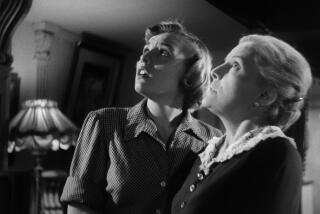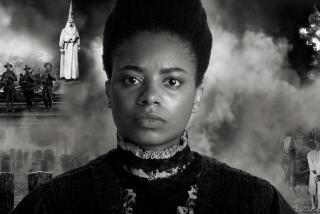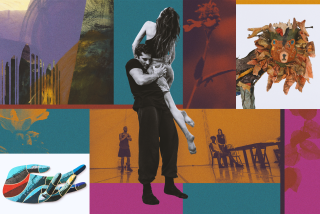Splendid restorations and new prints of beloved classics highlight UCLA Festival of Preservation
The circus no longer comes to town but fret not, the greatest cinematic show on Earth, otherwise known as the UCLA Festival of Preservation, has arrived for a one-month stay starting Friday night, and that is cause enough for gratitude and rejoicing.
Set up to celebrate and showcase the splendid restorations by UCLA’s world-class Film & Television Archive, the biennial event offers an unparalleled deep dive into the seldom-explored sea that is American film history, alternating between extreme rarities seen nowhere else and new prints of beloved movie classics.
The festival’s 20 multi-film programs, which will play at the Hammer Museum’s Billy Wilder Theater in Westwood until March 27, cover a remarkable range in time and taste. And they come from a variety of studios, running the gamut from majors like Fox and Paramount to minors like Tiffany, Eagle-Lion, Marathon and even World Wide, usually more celebrated for its risqué logo than its films.
What other series would encompass everything from Laurel & Hardy’s beloved “Sons of the Desert” and Kelly Reichardt’s debut independent feature “River of Grass” to the prescient Black Panther documentary “The Murder of Fred Hampton” and a gem from the Golden Age of television, 1962’s “Seven Times Monday” starring Ossie Davis and Ruby Dee?
Friday’s opening night double bill, combining 1932’s magnificent Ernst Lubitsch comic romance “Trouble In Paradise” with 1931’s long-thought-lost “I Take This Woman” costarring Gary Cooper and Carole Lombard before they blew up, is a perfect example of UCLA’s joining the familiar with the unusual.
Starring Herbert Marshall and Miriam Hopkins as high style thieves in love and Kay Francis as the heiress who threatens to come between them, “Paradise” is a triumph of timing and innuendo smartly written by Samson Raphaelson and directed by elegant farceur Lubitsch with his usual wit and flair.
“I Take This Woman,” unseen for decades because writer Mary Roberts Rinehart controlled the only print, is a rare chance to see Lombard and Cooper in the early stages of their careers, she as a madcap New York heiress exiled to Wyoming and he as the laconic cowboy (is there another kind?) she connects with.
Also offering a vivid glimpse of a major star’s early days is 1933’s “The Mad Game,” starring a vibrant Spencer Tracy as a gangster yearning for revenge.
Early and unseen films are, as always, a feature of the festival. You can watch an unbilled 23-year-old John Wayne as a stern fraternity boy in “Cheer Up and Smile” and see the Constance Talmadge 1920 silent comedy “Good References,” restored for what is said to be the first U.S. public screening in nearly 100 years after a single nitrate print turned up in Prague, Czech Republic.
A much stranger film, back on the screen after a print discovered in Adelaide, Australia, was combined with elements UCLA already had, is 1930’s “Mamba,” beautifully shot in the evocative but soon-to-be-outmoded two-color Technicolor.
Star Jean Hersholt, a long way from the humanitarian efforts that led to an honorary Oscar being named for him, plays a dissolute scoundrel in pre-World War I German East Africa, so loathsome he’s detested by everyone he meets, especially his aristocratic wife, played by the always elegant Eleanor Boardman.
One of the characteristics of this year’s festival is its concentration on programmers, 1930s quickies that were the B picture half of double bills and often boasted plots so unreal you might wonder if some Paris surrealist had had a hand in them. Two of the most intriguing are conveniently double-billed on March 12.
First comes “S.O.S. Tidal Wave,” a brisk 62-minute item made in 1939 and prescient enough to warn of the dangers of fake news on TV. It’s followed by 1932’s “False Faces.” Directed by and starring Lowell Sherman, this delirious ripped-from-the-headlines melodrama details the career of a formidably unethical doctor who practices plastic surgery without knowing a thing about it.
Speaking of dark characters, pound for pound many of the most entertaining films in the festival are the ones with film noir roots. These include:
— “He Walked by Night,” directed by Alfred Werker with uncredited work by the underappreciated Anthony Mann, this story of a police search for a canny killer is elevated to the crime stratosphere by John Alton’s black-and-white cinematography. No one shot noir like the inventive, unexpected Alton, and “Night’s” eerie, claustrophobic climax in the storm drains of Los Angeles is flat-out brilliant.
— “Open Secret,” a lean noir gem directed by John Reinhardt, blends noir tropes with a chilling, socially conscious plot about anti-Semitism threatening a small town.
— “The Lost Moment.” Based on “The Aspern Papers” and more Hollywood gothic than pure noir, this story of the hunt for lost love letters has more creepy moments than author Henry James would have thought possible.
Also on the dark side is 1956’s “Los Tallos Amargos” from Argentina, a fan favorite in noir festivals and playing on a March 4 double bill with “She-Devil Island.” Beautifully photographed and featuring a score by Astor Piazzolla, it demonstrates that the noir impulse traveled especially well.
The almost indefinable “She-Devil Island” is a 1936 English language film made in Mexico, part photographic celebration of Mexican culture, part troubled romance and part bizarre fantasy involving an island populated only by nubile women wearing sea-shell bikinis. Very strange indeed.
Utilizing almost the same title, though its feeling is very different, is 1934’s “She Devil,” also known by the more descriptive “Drums O’ Voodoo” title. Produced for what was known as the race market, “She Devil” was written by and stars African American playwright J. Augustus Smith, who plays a Christian minister who ends up allied with a powerful voodoo enchantress. Undeniably stage-bound but inescapably powerful, this is not like anything you may have seen before, which is as good a way as any to sum up what UCLA’s splendid festival is all about.
At the Billy Wilder Theater, Hammer Museum, 10899 Wilshire Blvd., Westwood. For more information: (310) 206-8013 or www.cinema.ucla.edu.
All screenings at 7:30 p.m. except as noted.
March 3: “Trouble in Paradise,” “I Take This Woman”
March 4 at 3 p.m. “Good References,” “The Poor Nut”
March 4 at 7 p.m.: “Los Tallos Amargos,” “She-Devil Island”
March 5 at 3 p.m.: “Seven Times Monday,” “Our Kind of World”
March 5 at 7 p.m.: “The Murder of Fred Hampton”
March 6: “The Vampire Bat,” “Almost Married”
March 9: “Stranded,” “The Plastic Dome of Norma Jean”
March 10: “He Walked by Night,” “Open Secret”
March 11 at 3 p.m. “The Mad Game,” “365 Nights in Hollywood”
March 11: Restored classic animated shorts
cas
March 12 at 7 p.m.: “S.O.S. Tidal Wave,” “False Faces”
March 17: “The George Shearing Show,” “Nancy Wilson at the Grove,” “Color Me Jazz”
March 18 at 3 p.m.: “Sons of the Desert”
March 18: “Mamba,” “Cheer Up and Smile”
March 19 at 7 p.m.: “God’s Step Children,” “She Devil”
March 20: “Infernal Machine,” “Sleepers East”
March 22: “River of Grass,” “The Watermelon Woman”
March 26 at 7 p.m.: “Gold Watch,” “CBS Children’s Hour”
March 27: “The Lost Moment”
More to Read
Only good movies
Get the Indie Focus newsletter, Mark Olsen's weekly guide to the world of cinema.
You may occasionally receive promotional content from the Los Angeles Times.











